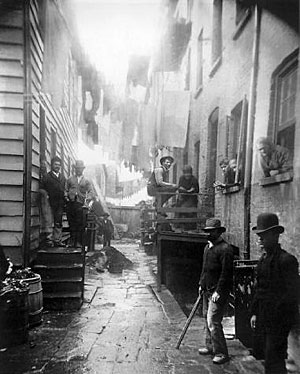Living in the City
At the same time that large numbers of African Americans from the South and poor foreign immigrants migrated to cities, professionals began to leave and build homes in suburban areas near cities. Better forms of transportation made getting to work possible. The Boston subway began running in 1897 and cable cars and trolleys became common in Western cities. Cities became living areas for the poor with exclusive areas for the very wealthy. Some owners of factories built housing for their workers. Most immigrants had to find their own apartments or rooming houses. Low-cost apartment buildings began to spring up in many cities. Commonly called tenements, these apartments often housed large families in unsanitary conditions. New York City had many tenement houses in the mid-1800s. The city established a Board of Health and passed a Tenement House Law which identified the minimum requirements to pass building inspections including:
- One water-closet (bathroom)
for every twenty occupants
Bandits Roost; photo by Jacob Riis
- Water-closets that are connected to a city sewer
- No occupants in the cellar or basement
- Ventilated sleeping areas
- Proper receptacles for garbage
- Free from dirt and filth
Violators of the Tenement House Law would have to pay fines of between $10 and $100. The large numbers of immigrants to New York City made it impossible to enforce the laws, however. With the invention of the elevator, tenement houses became even larger. While laws were passed to improve the living conditions, owners paid off inspectors and found loopholes to keep from building and maintaining appropriate living spaces. In the late 1800s photojournalist Jacob Riis exposed the deplorable conditions of tenement living in the book How the Other Half Lives, published in 1890.
Excerpt from his book:
Look into any of these houses, everywhere the same piles of rags, of malodorous bones and musty paper, all of which the sanitary police flatter themselves they have banished to dumps and the warehouses. Here is a 'flat' or 'parlor' and two pitch-dark coops called bedrooms. Truly, the bed is all there is room for. The family teakettle is on the stove, doing duty for the time being as a wash-boiler. By night it will have returned to its proper use again, a practical illustration of how poverty in 'the Bend' makes both ends meet. One, two, three beds are there, if the old boxes and heaps of foul straw can be called by that name; a broken stove with crazy pipe from which the smoke leaks at every joint, a table of rough boards propped up on boxes, piles of rubbish in the corner. The closeness and smell are appalling (64-65).